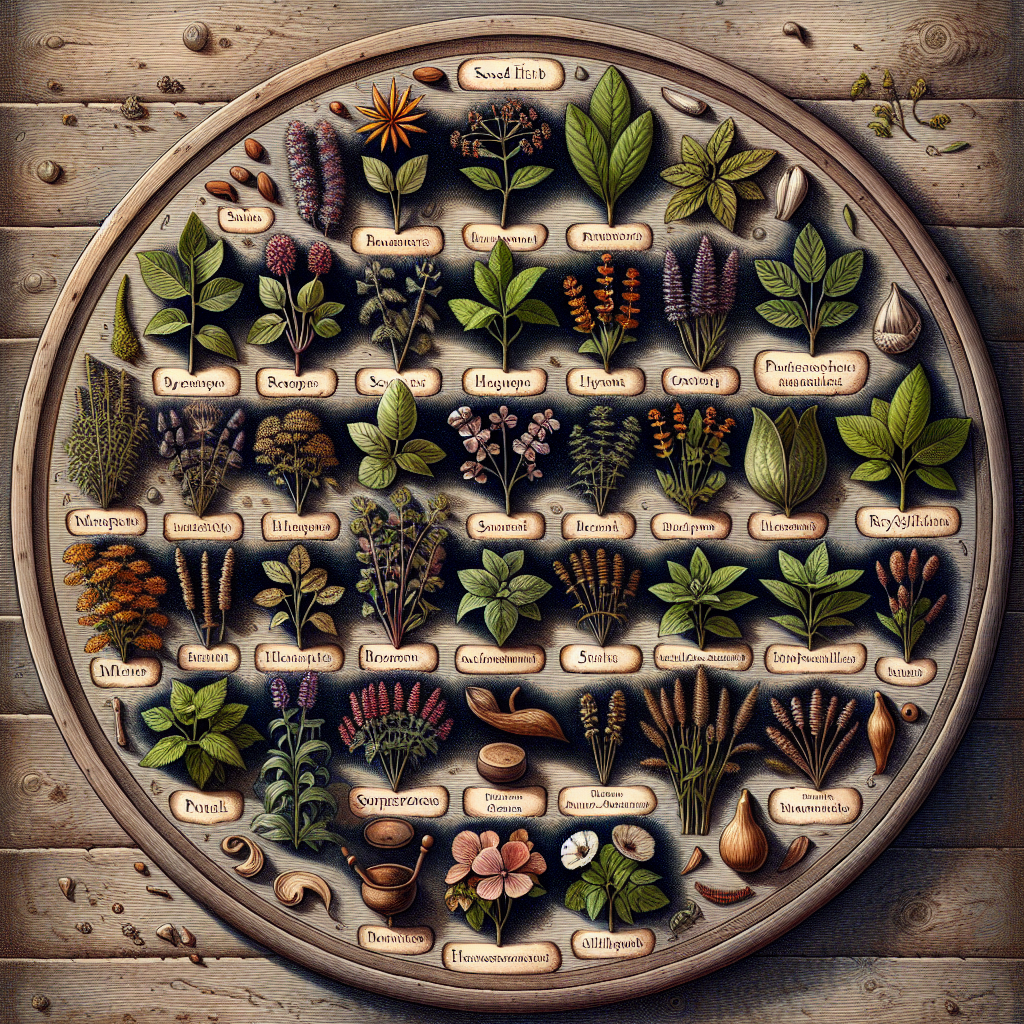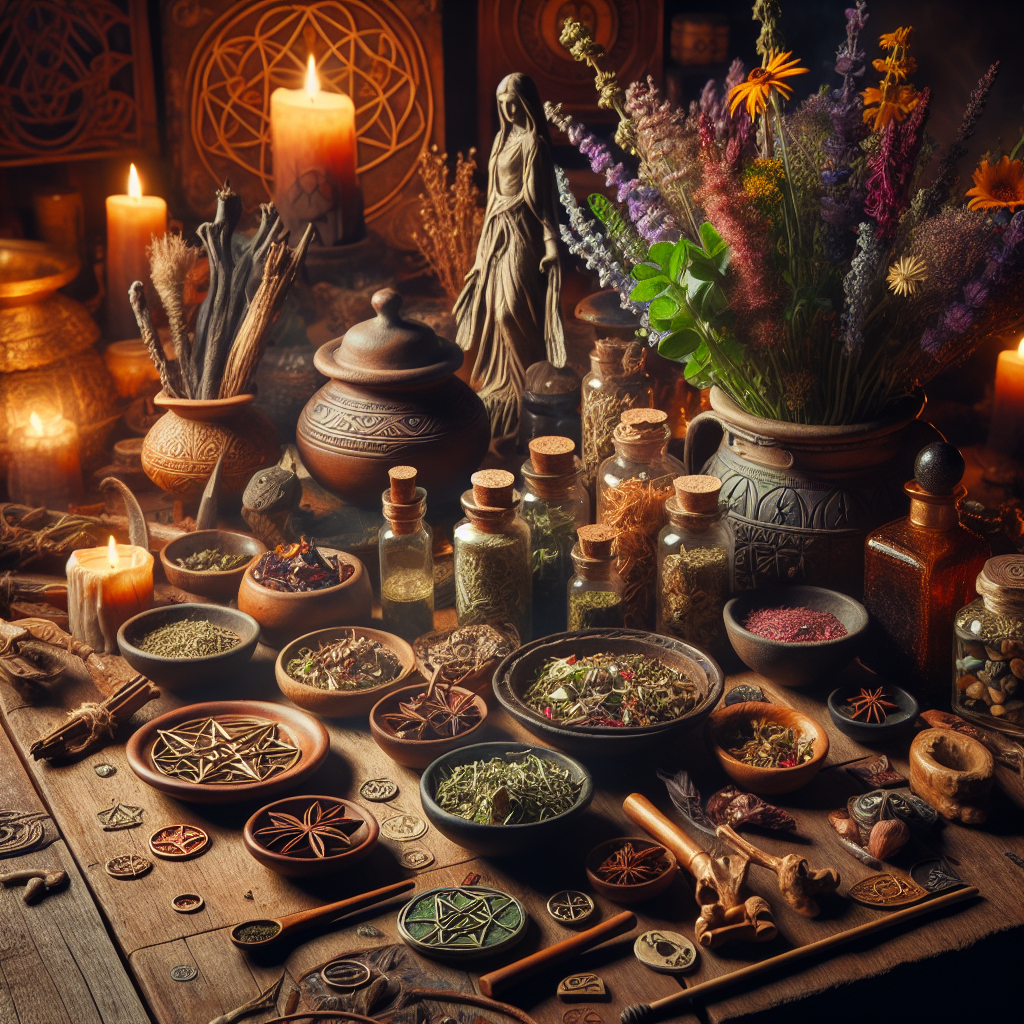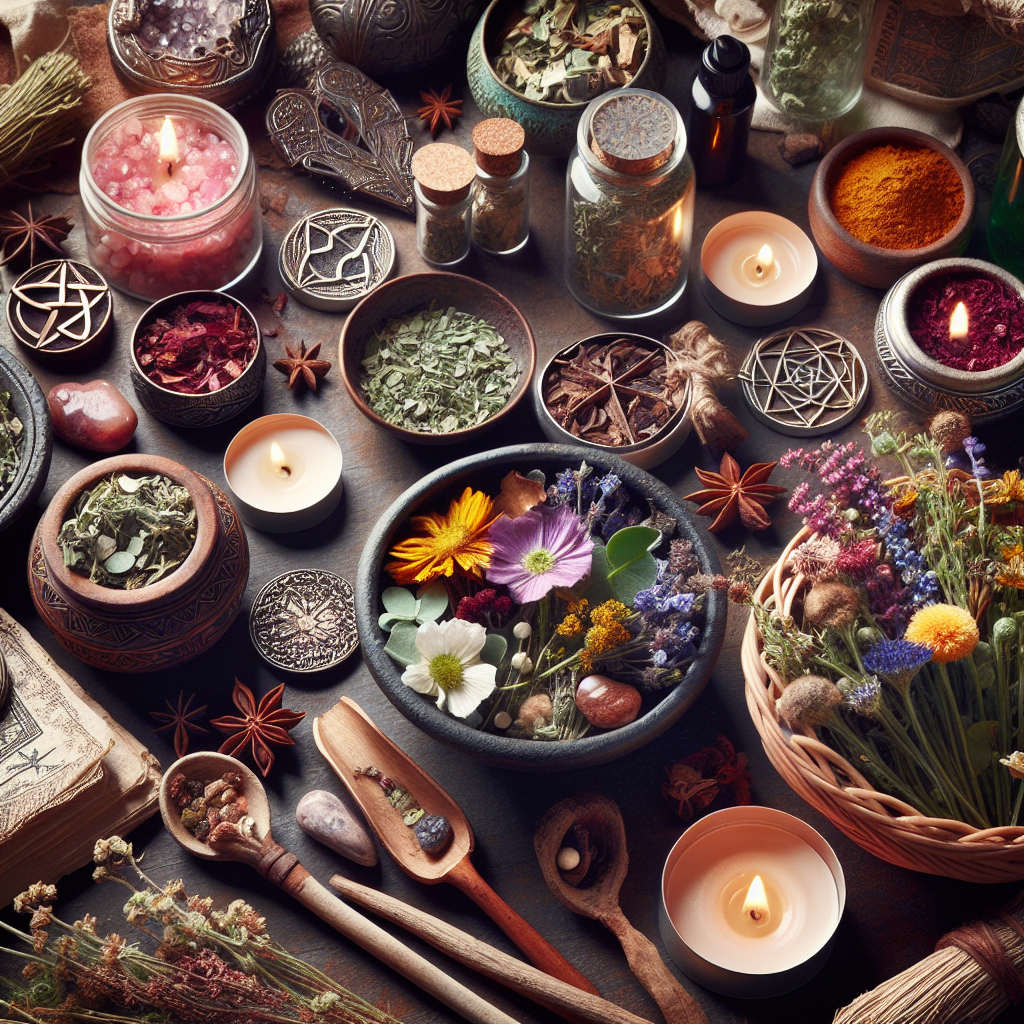As an Amazon Associate I earn from qualifying purchases.

Introduction to 20 Sacred Herbs in Pagan Rituals
Throughout history, sacred herbs have held significant spiritual ritualistic importance in various pagan traditions. These herbs are considered powerful tools for communication with the divine, the manifestation of intentions, and the attainment of personal and universal harmony. With roots in ancient civilizations, the use of sacred herbs in pagan rituals spans thousands of years and remains relevant in contemporary spiritual practices.
The rich tapestry of beliefs associated with these herbs showcases their multifaceted roles. In modern pagan practices, these herbs are often utilized for healing, protection, divination, and enhancing spiritual awareness. A renewed interest in herbalism and natural cures has surged in recent years, with statistics indicating a 52% increase in people seeking alternative medicine options, highlighting the continued significance of these practices.
Examples of Sacred Herbs and Their Ritual Uses
Sage: Widely known for its purifying properties, sage is often burned as incense to cleanse spaces and ward off negative energies. It can also be used in ceremonies to enhance wisdom and clarity.
Lavender: Frequently used to promote relaxation and peace, lavender is ideal for meditation rituals. Its calming scent is believed to aid in spiritual healing and stress relief.
Rosemary: Associated with memory and protection, rosemary is used in rituals to strengthen mental clarity and safeguard against harmful influences. It is also believed to improve intuition and insight.
Mugwort: Known for its visionary properties, mugwort is commonly used in divination and dream work. It helps to enhance psychic abilities and is often carried as a talisman for protection.
Basil: Known for its protective and love-creating properties, basil is used in rituals to attract affection and maintain family harmony. It is also used in spells to bring about prosperity and success.
Thyme: Symbolizing courage and strength, thyme is often burned as incense during rituals to boost confidence and bravery. It can also be placed under pillows to ward off nightmares and enhance positive dreams.
Mint: Renowned for its abilities to promote prosperity and clear thinking, mint is used in rituals to attract financial success and stimulate cognitive functions. It also serves as a potent protection herb.
Chamomile: Known for its connection to peace and purification, chamomile is used in rituals to ensure calmness and repel negative energies. It is commonly used in sleep and relaxation spells.
Bay Laurel: Historically associated with prophecy and divination, bay laurel leaves can be burned or worn during rituals to enhance psychic powers and protection.
Dandelion: Often linked to wishes and divination, dandelion is used in rituals to connect with spirits and improve divination abilities. Its leaves and flowers are also used to enhance healing properties.
More Sacred Herbs and Ritual Applications
Yarrow: Known for its protective properties, yarrow is used in rituals to guard against negativity and enhance psychic abilities. It is often placed in sachets or sprinkled around the perimeter of sacred spaces.
Juniper: With its powerful purifying abilities, juniper is used in rituals to cleanse environments and ward off evil spirits. It is also burned during important ceremonies to elevate spiritual presence.
Fennel: Fennel is used in protection and healing rituals, often for safeguarding health and providing strength. Its seeds can be carried in a sachet to ward off malicious influences.
Hawthorn: Traditionally linked to fairy magic and protection, hawthorn is used during Beltane celebrations to invite fertility and love. It also serves as an effective protective ingredient in rituals.
Vervain: Known for its magical and protective properties, vervain is used in a variety of rituals. It is believed to aid in divination and is often carried as a talisman for protection and good luck.
Elder: Revered in many pagan traditions, elder is associated with protection, healing, and the fairy realm. Its berries and flowers are used in rituals to summon protective spirits and enhance natural magic.
St. John’s Wort: Renowned for its potent protective qualities, St. John’s Wort is used in rituals to banish negative spirits and energy. It is also used to promote mental health and well-being.
Hyssop: Primarily used for purification, hyssop is believed to cleanse both spaces and people of negative energy. It is often incorporated into cleansing baths and ritualistic sprinklings.
Angelica: Known for its protective and healing properties, angelica is used in rituals to ward off evil and bring about healing. It’s also utilized to attract positive energy and good fortune.
Mistletoe: Often associated with peace and love, mistletoe is used in rituals to foster reconciliation and harmony. It is also known for its protective powers and is often hung in homes for protection and blessing.
Basil is revered for its protective qualities. Often used in purification rituals, its vibrant energy is said to ward off negative influences, making it a staple in spellcraft for protection and love.
Sage is one of the quintessential sacred plants in Pagan rituals. Its smoke is believed to cleanse spaces of negative energy, purifying both the area and the practitioners. Sage’s potent cleansing properties make it indispensable in spellcraft and ritual practices.
Lavender is cherished for its soothing properties. Beyond its appeal in aromatherapy, lavender is utilized in Pagan rituals to bring peace, harmony, and restful sleep. Its calming scent is thought to invoke tranquility and purity during spiritual ceremonies.
Rosemary stands as a symbol of memory and fidelity. Known as one of the most spiritual herbs, it’s often used in rites of remembrance and healing. Rosemary’s ability to enhance memory and protect against evil spirits solidifies its role in both rituals and spellcraft ingredients.
Mugwort has a strong association with divination and dreaming. This herb is often used in rituals to enhance psychic abilities and to stimulate prophetic dreams. Its potency is embraced by many seeking spiritual insight and connection.
Mint represents abundance and prosperity. As a part of ritual usage, mint is often featured in spells aiming to attract wealth and success. Its fresh aroma is also believed to stimulate mental clarity and decision-making.
Thyme is integral for courage and strength. Its spiritual significance in Pagan herbs is utilized often in charms and amulets to bolster confidence and bravery. Thyme’s versatile properties also include purification and healing.
Rue shines as a protective and banishing herb. Often used to ward off the evil eye and malevolent spirits, rue’s inclusion in spellcraft ranges from protective charms to spiritual cleansing rituals.
Calendula, also known as marigold, is famed for its bright energy, often utilized in sun magic. Its petals are employed in rituals to bring warmth, positivity, and vitality, making it a beloved element in spellcraft ingredients.
Yarrow stands for healing and love. Its use in spellcraft is extensive, with applications in love spells and protection amulets. Yarrow’s rich symbolism amplifies its role in many spiritual activities.
Vervain, esteemed for its enchanting properties, finds a place in love and protection rituals. Its spiritual uses extend to blessing spaces and enhancing one’s magical intents, securing its place as one of the significant Pagan herbs.
Dandelion converts wishful thinking into action. Its seeds are said to carry wishes to the spirits, making it a powerful ally in spells and rituals that focus on manifesting desires and goals.
Valerian is celebrated for its calming and sleep-inducing properties. In rituals, it is used to induce tranquility and even in love spells, owing to its reputation of bringing an undisturbed sleep and relief from anxiety.
Catnip, beyond its appeal to felines, holds a place in love and beauty spells. It is often included in Pagan rituals to enhance allure and attract affection, harnessed by those seeking to amplify their charm.
Cinnamon, known for its warming energy, is used to bolster success and prosperity in rituals. Its vibrant, spicy quality is utilized in spellcraft to accelerate outcomes and attract wealth and positivity.
St. John’s Wort provides protection and solar energy. It is often incorporated in rituals to dispel darkness and summon light, offering both protection and the stimulation of joy and positivity.
Dill is recognized for its ability to protect and attract love. Its inclusion in spellcraft serves to guard against harmful intentions and to magnetize romantic energies, making it a versatile sacred plant.
Chamomile is renowned for its calming effects, often used in relaxation and sleep rituals. Its soothing nature is also harnessed in rites meant to diffuse stress and invoke a serene state of mind.
Hyssop is a purifying herb often utilized in rituals to cleanse and sanctify spaces. Its strong association with spiritual purification makes it indispensable in spellcraft aimed at dispelling negativity and preparing sacred spaces.
Nettle symbolizes strength and protection. Its inclusion in rituals and spellcraft serves as a powerful guardian against harmful influences and to fortify the practitioner’s resilience and courage.
A recent survey indicated that over 62% of modern Pagan practitioners regularly incorporate herbs into their spiritual practices.
Personal Experience with Mugwort
Mugwort has been a staple in my practice for years. I remember the first time I used it in ritual; I felt an immediate connection to its energies. Coming from a long line of dreamers and intuition-seekers, I used dried Mugwort to enhance my dreams. I would place a small sachet of it under my pillow, and my dreams became more vivid and easier to recall.
During the autumn equinox, I often use Mugwort in preparation for the darker half of the year. I’ll burn it as incense before meditation, feeling its purifying smoke clear both my space and my mind. It’s a time when focus turns inward, and Mugwort aids in navigating those inner realms.
Mugwort’s efficacy extends to divination practices as well. When scrying, I like to anoint my tools with a Mugwort infusion. The slight tingling sensation it leaves on my skin feels like a gentle nudge from the spirit world, opening channels of communication that remain dormant otherwise.
Personal Experience with Sage
Sage is a herb that I often turn to for cleansing and protection. Every summer solstice, I gather fresh Sage to create smudge sticks for the year ahead. There’s something incredibly grounding about the act of bundling the Sage myself, knowing that I’ve harvested it respectfully and with intent.
The cleansing rituals I perform with Sage are deeply personal. Whenever I’ve moved into a new home, I begin by smudging each room, wafting the smoke into every nook and cranny. I find that it not only removes any residual energies from previous occupants but also sets a positive, intentional tone for my living space.
Sage also plays a vital role in my full moon rituals. As I lay out my crystals to bathe in lunar light, I’ll burn some Sage to infuse them with additional protective energy. Holding a smudge stick and watching the smoke curl upwards, I feel an intense connection to the natural world and its cycles.
Personal Experience with Rosemary
Rosemary has always been my go-to herb for remembering and honoring the past. I recall making a wreath of fresh Rosemary for my grandmother’s memorial, a tradition that has since become annual. The fragrance alone is enough to transport me to moments shared, bringing a comforting sense of continuity.
In ritual work, I often use Rosemary for its protective properties. Before entering a new endeavor or starting a significant ritual, I’ll create an anointing oil by infusing Rosemary in olive oil. I then use this oil to draw protective symbols on myself, such as on my wrists or forehead.
Beyond memorials and protections, Rosemary finds its way into my daily practices. I frequently use it in cooking, infusing not only flavor but also intent into my meals. Preparing and consuming a dish with Rosemary feels like an act of magic, embedding nourishment and protection directly into my body.
Personal Experience with Lavender
Lavender is synonymous with peace and calm in my rituals. Whenever I feel particularly stressed, I create a soothing lavender tea from dried flowers. The very act of sipping this tea allows my mind to slow down and my body to relax, creating a perfect state for meditation.
For Beltane, I often weave Lavender into floral crowns and garlands. The delicate scent transforms the space, making the celebration of fertility and growth even more profound. Lavender’s ability to instill peace helps balance the high energy of the festivities, ensuring that it remains joyous rather than overwhelming.
Another favorite use of Lavender in my practice is in sleep sachets. I’ve sewn small pouches filled with Lavender buds to place under my pillow. The gentle aroma is a nightly reminder to let go of the day’s stresses, guiding me into a restful and dream-filled sleep.
u003cH2u003e1. What are the 20 Sacred Herbs commonly used in Pagan rituals?u003c/H2u003e
u003cpu003eThe 20 Sacred Herbs include Sage, Lavender, Rosemary, Chamomile, Mugwort, St. John’s Wort, Juniper, Basil, Vervain, Thyme, Yarrow, Mint, Hyssop, Angelica, Rue, Dandelion, Nettles, Bay Laurel, Valerian Root, and Cedar.u003c/pu003e
u003cH2u003e2. What is the significance of Sage in Pagan rituals?u003c/H2u003e
u003cpu003eSage is widely used for its purification and cleansing properties. It is often burned as a smudge to clear negative energy from spaces, objects, and people.u003c/pu003e
u003cH2u003e3. How is Lavender used in spellcraft and rituals?u003c/H2u003e
u003cpu003eLavender is used for its calming and protective qualities. It is commonly included in rituals for peace, love, and protection, and is often used to make sachets or oils.u003c/pu003e
u003cH2u003e4. What are the spiritual benefits of Rosemary?u003c/H2u003e
u003cpu003eRosemary is associated with memory, fidelity, and cleansing. It is often used to enhance memory during study or rituals and to cleanse and protect sacred spaces.u003c/pu003e
u003cH2u003e5. Can Chamomile be used for more than just tea?u003c/H2u003e
u003cpu003eYes, Chamomile is also used in rituals for its relaxing and healing properties. It can be included in spellcraft for peace, love, and tranquility.u003c/pu003e
u003cH2u003e6. What is Mugwort commonly used for in Pagan practices?u003c/H2u003e
u003cpu003eMugwort is often used for its associations with dreams, psychic abilities, and protection. It can be burned as incense or placed under the pillow to enhance dreams and psychic visions.u003c/pu003e
u003cH2u003e7. How does St. John’s Wort function in rituals?u003c/H2u003e
u003cpu003eSt. John’s Wort is traditionally used for protection against negative energies and to bolster mood and well-being. It can be included in amulets or burned as part of a ritual.u003c/pu003e
u003cH2u003e8. Are there any herbs specifically for love spells?u003c/H2u003e
u003cpu003eYes, herbs like Basil, Lavender, and Rose are often used in love spells. They can be incorporated in sachets, baths, or candle magic to attract love and friendship.u003c/pu003e
u003cH2u003e9. What role does Vervain play in spells and rituals?u003c/H2u003e
u003cpu003eVervain is known for its protective and purifying properties. It is commonly used in rituals to ward off evil, protect spaces, and enhance magical work.u003c/pu003e
u003cH2u003e10. Can herbs be used safely by beginners in Pagan rituals?u003c/H2u003e
u003cpu003eYes, many herbs are beginner-friendly as long as they are used with care and respect. It is essential to research each herb’s properties and corresponding uses, and to consider any potential allergic reactions.u003c/pu003e

## Conclusion
In exploring the 20 sacred herbs commonly utilized in Pagan rituals, the article underscores the profound connection between nature and spirituality that lies at the heart of Pagan practices. Each herb holds unique qualities and energies that practitioners harness to enhance their spells, rituals, and spiritual journeys. Herbs like Sage, used for purification and protection, and Mugwort, which aids in divination and enhancing psychic abilities, reveal the diverse ways in which these plants serve essential roles in aligning the physical and spiritual realms. The versatile use of these sacred plants extends to ritual baths, incense, teas, and charm bags, showcasing their integral role in fostering a harmonious balance between the practitioners and natural world energies.
Moreover, the cultivation and ethical sourcing of these spiritual herbs are emphasized, ensuring that their use is sustainable and respects the environment from which they come. The wisdom passed down through generations regarding the harvesting times, preparation methods, and specific applications enriches the ritualistic practices, imbuing each ritual act with deeper meaning and potency. Spellcraft ingredients like Rosemary for memory and love, and Lavender for tranquility and peace, complement the magical workings, providing a tangible link to the Earth’s nurturing essence. Ultimately, the article illuminates the sacredness imbued within each herb, inviting practitioners to deepen their reverence for the natural world while enriching their spiritual practices with time-honored ritualistic traditions.
Amazon and the Amazon logo are trademarks of Amazon.com, Inc, or its affiliates.


